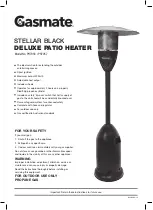
Page 16 of 21
507858-01
Issue 1922
Adjustments – Heating Section
Temperature Rise
At time of installation, the temperature rise must be
adjusted to be within the range specified on the unit rating
plate.
Checking and Adjusting Gas Input
The gas input must not exceed the figures shown on the
rating plate. The unit is equipped for rated inputs with
manifold pressures of: 3.5” w.c. for natural gas and 10.0”
w.c. for propane. The furnace requires conversion for use
with propane (a propane conversion kit is available from
the manufacturer).
The manifold pressure can be measured by removing the
pipe plug in the downstream side of the gas valve and
connecting a water manometer or gauge.
Only small variations in gas input may be made by adjusting
the regulator.
In no case should the final manifold
pressure vary more than 0.3” w.c. for natural gas or
0.7” w.c. for propane.
The furnace rate must be /- 2% of the appliance
rating input.
WARNING
To adjust the regulator, turn the adjusting screw on the
regulator clockwise to increase pressure and input or
counterclockwise to decrease pressure and input.
BTU/HR
Input
=
Cubic Feet per
Revolution
x
3600
x Heating
Value
# Seconds per
Revolution
For Natural Gas:
Check the furnace rate by observing
the gas meter, when available, making sure all other gas
appliances are turned off. The test hand on the meter
should be timed for at least one revolution. Note the
number of seconds for one revolution.
The heating value of the gas can be obtained from the
local utility company.
For Propane Gas:
The only check for the furnace rate is
to verify proper orifice spud size is installed and properly
adjust the manifold pressure using a manometer. Typical
manifold set point for installations is 10.0” W.C.
Adjustments – Cooling Section
No adjustments are required or should be attempted
regarding any of the components of the cooling system.
The system should be checked to see that none of the
wiring is loose or missing.
Blower
The unit contains a direct-drive, multispeed blower. The
proper speeds have been preset at the factory for typical
heating and cooling operation. Refer to the wiring diagram
for recommended heating/cooling speeds for specific
models. Speeds may require adjustment due to duct
design and application. Direct-drive blower motors are
permanently lubricated and do not require oiling.
Blower Operation
Continuous operation of the air handling blower will be
obtained if the thermostat fan switch is set to “ON”. With
the thermostat fan switch set to “AUTO”, the air handling
blower will cycle corresponding with the thermostat cycling.
Fan Control
The blower will start approximately 30 seconds after the
burners ignite and will stop approximately 120 seconds
after the thermostat is satisfied. The time delay is preset at
the factory and timing cannot be adjusted.
When the thermostat system switch is set for “COOL”, the
blower will start 5 seconds after the thermostat calls for
cooling and will stop 90 seconds after the thermostat is
satisfied.
A fan switch is provided on the thermostat which will bring
the blower on for continuous operation when the switch is
set for “ON”.
Limit Control
A fixed temperature limit control is provided which will shut
off the gas to the burners if the unit is overheated for any
reason. The control must not be adjusted or relocated.
Rollout Switch
If for any reason the heat exchanger were to become
blocked, there is a temperature sensitive switch located
above the burners that will turn off the burners. After
correcting the problem, this switch must be manually reset
by pressing the button on top of it.
Installation and Operation in Extremely Cold
Weather Areas
In areas where extremely cold outdoor temperatures (below
– 20°F) can be expected, some additional installation and
operating precautions should be taken. The following
precautions are designed to prevent possible vent system
ice blockage that could result in safety shutdown of the
burners:
1. Adjust to the highest achievable temperature rise
within the rise and static pressure ranges specified
on the rating plate. Depending on specific model, it
may be possible to change to a lower heating blower
speed tap to get a higher temperature rise. This also
increases comfort.






































